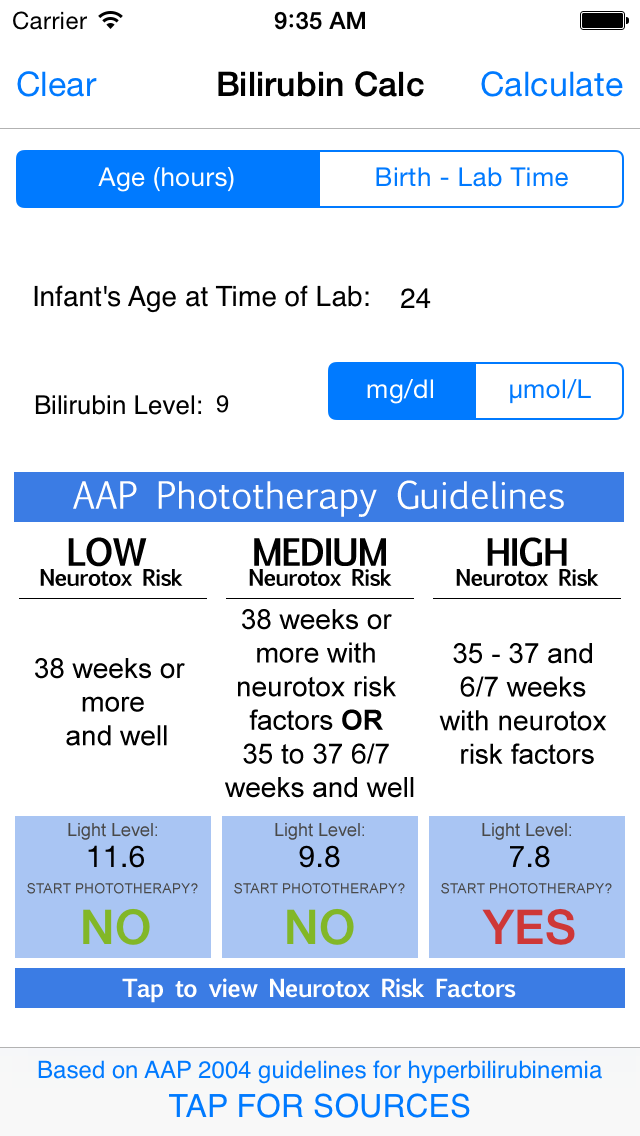
BiliCalc
| Category | Price | Seller | Device |
|---|---|---|---|
| Medical | $1.99 | Jacob Beniflah | iPhone, iPad, iPod |
Allows direct age input and includes the option to calculate age from birth and lab sample times. The app has a direct link to source journal articles, nomograms, and a list of the neurotoxicity risk factors. Supports US and SI units (mg/dL and µmol/L).
App Feature Summary
-Calculates phototherapy threshold for newborns 35 weeks and older
-Displays values on phototherapy nomogram
-Suggests time frame for followup bilirubin levels based on patient risk zone
-Direct links to reference journal articles
**********************************
Frequently Asked Questions
**********************************
1. I think the graph is backwards. Why is low risk on top and high risk on bottom?
The graph is directly from the 2004 AAP Hyperbilirubinemia Guidelines. The degree of "risk" refers to the infant's risk for developing neurotoxicity. This is different than the Bhutani Nomogram in which "risk" refers to the risk for development of severe hyperbilirubinemia. The threshold for treatment (when a data point lies above one of the lines on the graph) of the infant is different based on the predisposing factors (divided into the three risk categories). Babies who are "low neurotoxicity risk," can tolerate higher levels of bilirubin than a baby with medium or high risk. Therefore, a high risk baby will be treated at lower bilirubin levels than a low risk baby. The graph is correct in having low risk on top since a higher value is needed to pass the threshold for treatment (phototherapy). Please see the graph here for verification as well: http://bit.ly/AppPWU. Please email if you have further questions.
******************************************
Intended for use by pediatricians, neonatologists, physicians, medical students, and pediatric nurses who treat newborn infants in the hospital and as outpatients.
BiliCalc should be used only as a reference aid. The information contained in the app should not be used as a substitute for the exercise of professional clinical judgement. Please contact the developer if you find any errors.
Keywords: bilitool, bilitool.org, jaundice, hyperbiliubinemia
Reviews
Inaccurate
duuehueijxAggzhssjdnxua
Intermittently inaccurate plotting of bili values on graphs. Dangerous if you don’t realize it b/c app plots bili at lower than value entered.
No longer accurately plotting risk
TrueB
Using iOS 11. Do not use this app, it is no longer accurate.
Great idea!
DocDren
I am so glad there is finally an app for this! This is a must have for all pediatricians!
Perfect app
KratosAur
Does just what it advertises. Perfect for any pediatrician or anyone who has a need to make this calculation quickly. Free as well. Can't beat that.
Simple and Very Useful!
suey_311
Great new app! Love the layout. Simple to use. Links to the resources a bonus... And FREE! A must for medical students, residents, nurses, and practicing physicians.
Amazingly helpful!
Erin Ross
This app made life SO much easier while rotating in the newborn nursery. It's extremely easy to use AND its free...even better!










